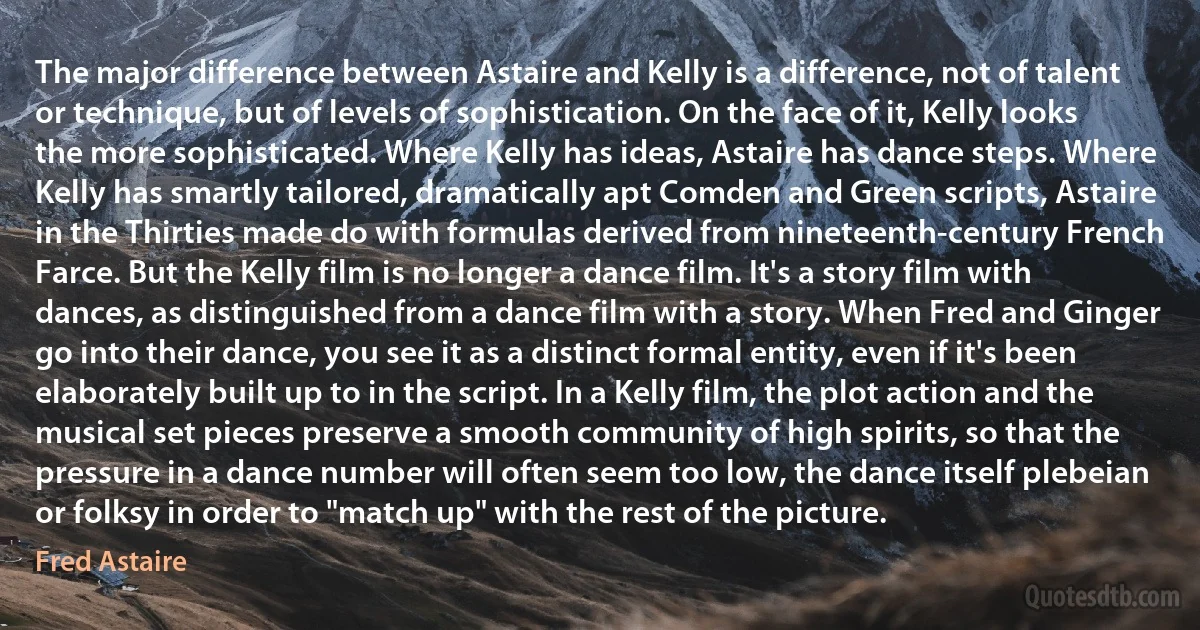
The major difference between Astaire and Kelly is a difference, not of talent or technique, but of levels of sophistication. On the face of it, Kelly looks the more sophisticated. Where Kelly has ideas, Astaire has dance steps. Where Kelly has smartly tailored, dramatically apt Comden and Green scripts, Astaire in the Thirties made do with formulas derived from nineteenth-century French Farce. But the Kelly film is no longer a dance film. It's a story film with dances, as distinguished from a dance film with a story. When Fred and Ginger go into their dance, you see it as a distinct formal entity, even if it's been elaborately built up to in the script. In a Kelly film, the plot action and the musical set pieces preserve a smooth community of high spirits, so that the pressure in a dance number will often seem too low, the dance itself plebeian or folksy in order to "match up" with the rest of the picture.
Fred AstaireRelated topics
action built dance difference entity face film formal fred french green high longer low match number order picture plebeian preserve rest script see set smooth sophistication story talent technique astaire looksRelated quotes
Hitherto he has found in Western music, in Bach above all, everything he needs. Now he encounters something that is not in Bach, though there are intimations of it: a joyous yielding of the reasoning, comprehending mind to the dance of the fingers. He hunts through record shops, and in one of them finds an LP of a sitar player named Ustad Vilayat Khan, with his brother - a younger brother, to judge from the picture - on a veena, and an unnamed tabla player. He does not have a gramophone of this own, but he is able to listen to the first ten minutes in the shop. It is all there: the hovering exploration of tone-sequences, the quivering emotion, the ecstatic rushes. He cannot believe his good fortune. A new continent and all for a mere nine shillings! He takes the record back to his room, packs it away between sleeves of cardboard till the day he will able to listen to it again.

J. M. Coetzee
You'd be alone in the kitchen and twilight would be dwindling, and you could hear the far off cries of the other children playing nearby. You'd be alone in the kitchen because it was your special treat time, where the jelly would come out just for you, and your mother would appear at your side just as a vision of Laura Ashley print dress, smelling of magnolias and biscuits and put the jelly in front of you, and you would pull your chair in. Then the old fashioned bar of ice cream would come down, the one that had to be cut with a breadknife before the two sides were flanked with wafers. You would lift your little spoon up excitedly and winkle out that first divet of black jelly... AND THEN THE CAGE COMES DOWN! The cage with the Japanese fighting spiders inside, your mother strikes a match off her forearm and tells you to dance in the front room for money... You, you never forget that shit, I mean it never goes away.

Dylan Moran
I would give a good deal of money, blood, books or years to be able to watch as Amanda, in a picture hat, looked back from the vantage of a long and productive career to reject her first published efforts as uneven or only halfway there or, worst of all, as promising, or to see her condescend to them, cuddle them almost, as mature writers sometimes do with their early books, the way we give our old stuffed pony or elephant, with its one missing shirt-button eye, a fond squeeze before returning it to the hatbox in the attic.At bottom of this kind of behavior on the part of old, established writers is the undeniable way in which our young selves, and the books that issued from them, invariably seem to reproach us: with the fading of our fire, the diminishment of our porousness to the world and the people in it, the compromises made, the friendships abandoned, the opportunities squandered, the loss of velocity on our fastball.

Michael Chabon
I think I can pinpoint the one moment when the American style of dressing first appeared. It was in an appalling 1933 movie called Dancing Lady during an otherwise forgettable dance number. It also just happened to be Fred Astaire's first on-camera dance. But don't look at the steps. Look at the outfit: Astaire is wearing a single-breasted, soft flannel suit with two-tone spectator shoes and a turtleneck. You wish you could look that stylish! Later that year, in Flying Down to Rio, we get the full Astaire impact. The muted plaid suit is not all that striking, but Fred is wearing it with a soft button-down shirt, a pale woven tie, silk pocket square, bright horizontally striped hose and white bucks. Whoa! Now that's different. This melange of the classic and the sporty was an American innovation. As we approach the impeccable Astaire's 100th birthday on May 10, it's worth remembering that he remains the greatest exemplar of that style.

Fred Astaire
Fred taught me a step because I said I can't let this experience be over without my learning something. He taught me the most wonderful Fred Astaire-like step, with an umbrella. It was a complete throwaway; it was almost invisible. It was in the way he walked. As he moved along, he bounced the umbrella on the floor to the beat and then he grabbed it. It was effortless and invisible. As a matter of fact, a few years later I was photographing Gene Kelly and told him that Fred Astaire had taught me this trick with an umbrella. And Kelly said, "Oh I'll teach you one," and he did, and the two tricks with the umbrella in some way define the difference between Fred Astaire and Gene Kelly, and, in my view, demonstrate who is the greater of the two artists. With Gene Kelly, he threw the umbrella way up into the air, and then he moved to catch it, very slowly, grabbing it behind his back. It was a big, grandstand play, about nothing.

Fred Astaire
